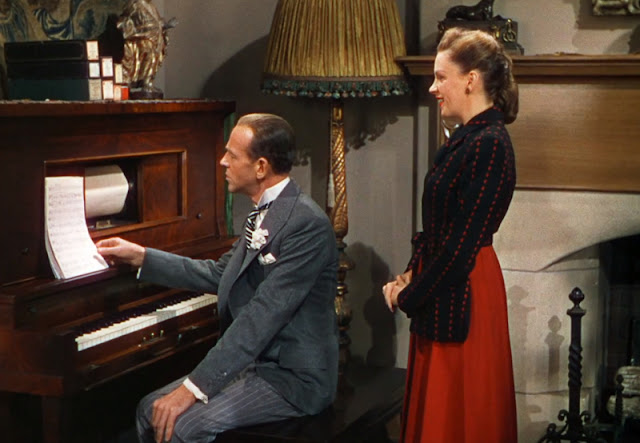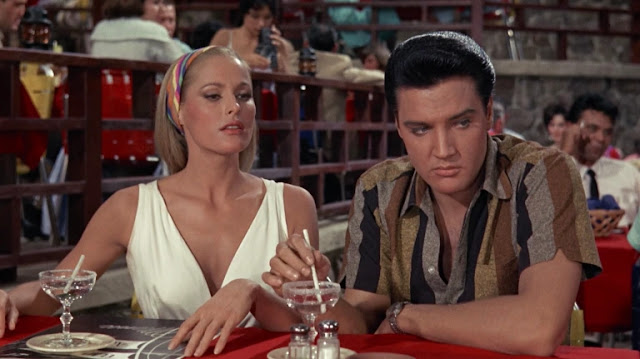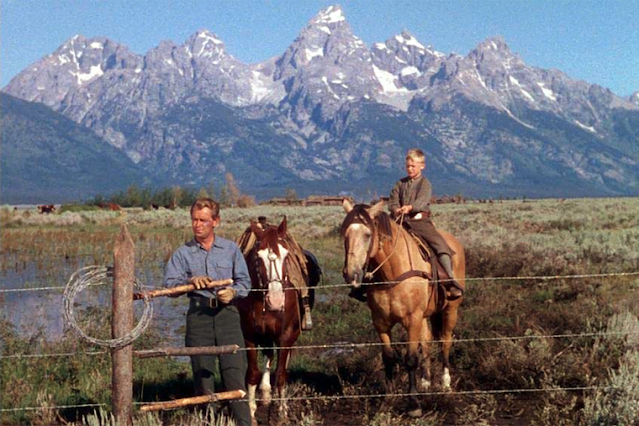I want to share a quick story about a college student who never saw a
Western until she had to take a class on Westerns. As part of a critical
thinking class, I had to take a film course titled "War and Westerns."
Oh boy. Up Until 1994, the only Western film I had ever seen was "Young
Guns" in 1988. I don't think I purposely avoided them, but I was too
much into my RKO musicals and melodramas to care. Back then - before the
internet, we had to read tons of copied notes from our professor; my
syllabus was as thick as the Yellow Pages. "What did I get myself into?"
I asked myself. My thesis was centered around the depiction of women in
war films, but that's for another post. But what happened was
incredible—a new appreciation for both genres and a lifelong love for
them.
I discovered that Westerns often explore similar themes, including
life, love, loss, betrayal, revenge, community, and honor, amongst other
things. The closest I came to knowing about frontier life, or cowboys,
and Indians was my favorite childhood show, Little House on the Prairie.
Back then, you checked out films from the school library to watch them
before discussing them in class. I didn't have cable or TCM just yet.
Fortunately, due to that class and library, I was able to watch classic
Westerns like High Noon, The Searchers, Stagecoach, 3:10 to Yuma,
and more. I fell in love with cinema again with an entirely new genre
to my hungry and wide-open eyes. Over the past couple of years, I've
seen dozens of classic Westerns. The characters that inhabit the Western
genre are endlessly fascinating to me, and yet they are honestly simple
as well.
These
classic Westerns capture a time of rugged individualism and moral
dilemmas on broad landscapes, where heroes and villains faced off under
the burning sun. Expansive landscapes, fascinating characters, and
gripping stories define this genre. Classic Westerns depict a world that
is raw and untamed. There is no shine or glamour; it's all about
survival and, more often than not, down to the grit of one man or
woman’s life struggles. There is an escapist quality to Westerns. The
stories are realistic, but they’re set in a time and a place so remote
from where a young girl living in the Bronx could imagine.
Having said that, I fell in love with the cinematography, beautiful landscapes, and scenery of these classic works of art.
Here are just some of the classic Western films that I love:
Westerns with Barbara Stanwyck in it! She appeared in 10 of them over a 20-year period
 |
| Stanwyck in Annie Oakley (1935), Forty Guns (1957), The Maverick Queen (1956), The Moonlighter (1953), and Union Pacific (1939) |
Americanism and the triumph of pioneers, stylistic storytelling in The Covered Wagon (1923).
Hatred, anger, and racism in The Searchers (1956) and Flaming Star (1960).
 |
| John Wayne & Natalie Wood in The Searchers (1956) |
%202.jpg) |
| Elvis Presley & Steve Forrest in Flaming Star (1960) |
Corrupt leadership and mob rule in The Ox-Bow Incident (1943).
%202.jpg) |
Anthony Quinn, Dana Andrews, Henry Fonda, Frank Conroy and Jane Darwell
|
Comedies like Blazing Saddles (1975), The Rounders (1965) and Destry Rides Again (1939).
%202.jpg) |
| Cleavon Little & Gene Wilder in Blazing Saddles (1975) | | |
 |
Glenn Ford & Henry Fonda are The Rounders (1965)
|
%202.jpg) |
| Marlene Dietrich is riding high with James Stewart in Destry Rides Again (1939) |
Manifest destiny and the building of the Transcontinental Railroad in The Iron Horse (1924) and How the West Was Won (1962).
.jpg) |
| The Iron Horse (1924) |
.jpg) |
How the West Was Won (1962) with James Stewart, Thelma Ritter, Robert Preston & Debbie Reynolds
|
Myth vs reality and the historical outlaw in Jesse James (1939).
.jpg) |
Tyrone Power, Henry Fonda and Jane Darwell
|
Hope, forgiveness, and second chances in Hell's Heroes (1929).
 |
| Charles Bickford, Raymond Hatton, and Fred Kohler |
The female driven musicals Calamity Jane (1953) and Cat Ballou (1965).
 |
| Doris Day is Calamity Jane (1953) |
%202.png) |
| Nat King Cole & Stubby Kaye narrate in song in Cat Ballou (1965) starring Jane Fonda |
Guilt, regret, and the inescapable cycle of violence in The Gunfighter (1950).
 |
| Gregory Peck is The Gunfighter (1950) |
Fear, courage, and the desire for a peaceful life in The Fastest Gun Alive (1956).
.jpg) |
| Glenn Ford & Broderick Crawford in The Fastest Gun Alive (1956) |
Film-noirs Pursued (1947), Blood on the Moon (1948) and Bad Day at Black Rock (1955).
,.png) |
| Robert Mitchum & Teresa Wright in Pursued (1947) | | |
 |
Robert Mitchum, Barbara Bel Geddes in Blood on the Moon (1948)
|
%202.jpg) |
Spencer Tracy is having a Bad Day at Black Rock (1955) with Robert Ryan
|
The confrontation between old and new in Lonely Are the Brave (1962).
.jpg) |
| Kirk Douglas in Lonely Are the Brave (1962). |
Feminism, blacklisting, sexuality, persecution in Johnny Guitar (1954).
.jpg) |
Sterling Hayden as Johnny Guitar strolls into town just in time for a showdown between Joan Crawford & Mercedes McCambridge
|
The death of the old West and its heroes in The Man Who Shot Liberty Valance (1962).
%204.jpg) |
| John Wayne, James Stewart, Vera Miles, Edmond O'Brien, Lee Marvin in The Man Who Shot Liberty Valance (1962). |
Greed and revenge in Winchester '73 (1950), Backlash (1956), The Good, The Bad and The Ugly (1966).
%202.jpg) |
| James Stewart & Shelley Winters in Winchester '73 (1950) |
Richard Widmark, Donna Reed and Barton MacLane in Backlash (1956)
.jpg) |
| Clint Eastwood, Eli Wallach and Lee Van Cleef are The Good, The Bad and The Ugly (1966). |
Honor, justice, and the struggle for survival in Shane (1953).
%203.jpg) |
| Alan Ladd is Shane (1953), with Van Heflin, Jean Arthur, Jack Palance and Brandon deWilde |
Good vs evil in 3:10 to Yuma (1957), and Silverado (1985).
%203.jpg) |
| Van Heflin & Glenn Ford in 3:10 to Yuma (1957) |
.jpg) |
| Danny Glover, Kevin Kline, Scott Glenn and Kevin Costner in Silverado (1985) |
Love, marriage, and the role of women in early America in Rachel and the Stranger (1948).
,.jpg) |
| Loretta Young, William Holden & Robert Mitchum |
The futility of violence in The Big Country (1958).
_NRFPT_03.jpg) |
| Gregory Peck, Burt Ives, Jean Simmons and Charlton Heston |
Coming of age and justice in The Tin Star (1957).
%203.jpg) |
| Henry Fonda & Anthony Perkins |
Sexual desire in Duel in the Sun (1946).
%203.jpg) |
Jennifer Jones & Gregory Peck
|
Female empowerment and independence during the pre-Civil War expansion of the West in Westward the Women (1951).
.jpg) |
Robert Taylor, Julie Bishop, Denise Darcel, Beverly Dennis, Marilyn Erskine, Lenore Lonergan, and Renata Vanni
|
Survival in the wilderness in Jeremiah Johnson (1972).
%202.jpg) |
| Robert Redford |
And the clash between the rugged, untamed West and the advancing wave of modernization in Once Upon a Time in the West (1968).
..jpg) |
| Henry Fonda, Claudia Cardinale, Sergio Leone, Charles Bronson, and Jason Robards |
These
gorgeous films offer stunning visuals and complex characters, making
for a one-of-a-kind viewing experience. The genre combines beautiful
cinematography, often featuring natural light and landscapes, with
powerful storytelling themes like justice, redemption, and human nature.
Legendary actors give layered performances that enhance the story,
while the film-making techniques elevate the overall experience. The
Western genre has a rich history that goes back over a hundred years,
starting in the early days of American cinema. The first Westerns
appeared in the early 1900s during the silent film era, influenced by
dime novels and Wild West shows.
A key early film was The Great Train
Robbery (1903). With the introduction of sound, westerns evolved
significantly, allowing for more complex storytelling that tackled
themes of morality, justice, and human nature. A lot of the early
Western movies were popular with kids, who loved going to cheap daytime
showings. These action-filled Westerns were perfect for the low-budget
film scene. Theaters in Los Angeles that focused on Westerns said their
biggest issue was getting kids to leave the theater, not getting them to
come in! They even had to check cap guns at the entrance because the
screenings sometimes turned into pretend shootouts. Many of these films
were made in a series, featuring the same main actors, which created a
universe that audiences loved and recognized.
In
1948, Westerns accounted for 25% of the films produced in Hollywood.
Producer Harry Sherman, famous for bringing Hopalong Cassidy to the big
screen, had already made 157 Westerns by then. He believed that any of
these films, which cost up to $1.5 million, were “as reliable as ham and
eggs.” The success of this genre depended on three main ingredients:
action, putting the hero in peril, and exciting chases.
The
Golden Age of Westerns introduced iconic actors like John Wayne, Gary
Cooper, and Henry Fonda, who embodied the cowboy “hero” in films. This
classic Westerns of this period tackled the moral dilemmas faced by
people living on the frontier and challenged the idealized image of the
American West. Renowned directors like John Ford and Howard Hawks played
a significant role in enhancing the genre with their unique
storytelling and visual techniques. By the late 1940s and into the
1950s, the genre began to take a darker turn, focusing more on the
psychological aspects of characters in what became known as the
psychological Western. In 1958, Hollywood released 54 Western films,
making up about 28% of all movies that year. Some standout titles from
this period include the well-known film High Noon, John Ford’s classic The Searchers, and Howard Hawks’s hit Rio Bravo,
which featured a star-studded cast. There were also several Westerns
directed by Anthony Mann starring Jimmy Stewart, and let’s not forget
George Stevens’s epic film Giant.
These classic films helped keep the Western genre thriving. The biggest
star of this time was John Wayne, who dominated Hollywood in the 1950s.
It's also important to highlight the popularity of TV Westerns, with 30
different shows airing during prime time by 1959. By the late 1960s,
traditional Westerns began to wane in popularity, paving the way for new
series that mixed Western elements with genres like family drama,
mystery, crime, and even Kung-fu. Today, it's evident that both
television and streaming services have transformed the Western genre,
venturing into new and creative directions. Notable series such as Deadwood, Justified, and Yellowstone,
along with its spinoffs 1883 and 1923, showcase timeless frontier
themes, including the conflict between nature and civilization,
generational challenges, the treatment of Native Americans, and the
varied roles of women within these stories.
Watching
Westerns lets viewers dive into a crucial era of American history,
highlighting some of the most fascinating and impactful films ever made.
I continue to explore classic Western films regularly. I suggest
checking out some neo-Western titles such as Silverado (1985), Unforgiven (1992), Tombstone (1993), Open Range (2003), No Country for Old Men (2007), Old Henry (2021), and Horizon (2024). Western
films are an essential part of cinema that deserves more recognition. I
can't stress enough how amazing these movies are.You need to make them a
part of your film watching repertoire - you can thank me later
‘pardner!


%20_%20-%20www.youtube.com.png)
%20_%20-%20www.youtube.com.png)


%20_%20-%20www.youtube.com.png)























.png)

.jpg)
%202.jpg)
.jpg)
%202.jpg)
.jpg)
%202.jpg)


.jpg)
%202.jpg)
.png)
.jpg)
%205.jpg)
%204.jpg)
.jpg)

.jpg)


,.jpg)
.jpg)

%203.jpg)
%202.png)
,.jpg)


.jpg)

,.png)
.png)

.jpg)
%202.jpg)
%202.png)
.jpg)
%204.jpg)
.jpg)
%202.jpg)
%204.jpg)
%203.jpg)
%202.jpg)
.jpg)
%202.jpg)
%202.jpg)
.jpg)


%203.jpg)
.jpg)
%203.jpg)
%203.jpg)
.jpg)
,%202.jpg)
,.jpg)

%203.jpg)
_NRFPT_03.jpg)
%202.jpg)
%203.jpg)
.jpg)
%203.jpg)
%202.jpg)
.jpg)
%203.jpg)
%202.jpg)
.%202.jpg)
.%2034.jpg)
..jpg)